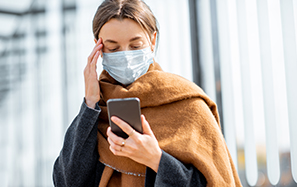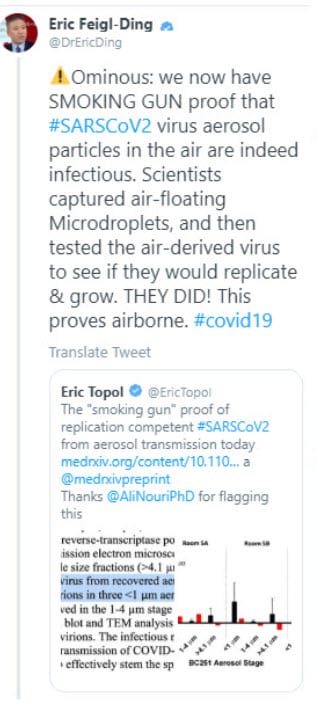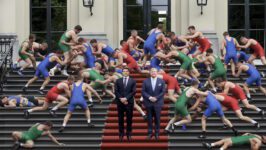A new category of "deniers" has emerged: aerosol deniers. Scientists who will tell you they are strictly scientific, but act on the basis of power instead. Reluctant to open themselves up to facts, they are responsible for a lot of unnecessary damage. This article shows the bewildering stubbornness of the Dutch CDC in denying the importance of aerosols.
Lees volledig artikel: The aerosol deniers
The aerosol deniers
We’ve added a new category of “deniers”: the aerosol deniers. Scientists, who will tell you “we are purely scientific”, but in reality act on the basis of power. They are reluctant to open themselves up to facts. And in this corona crisis they are responsible for a lot of unnecessary damage.
Unfortunately, there are a lot of these people. They form a power block within the WHO and also in the Netherlands they control the RIVM (Dutch CDC). Van Dissel (director of RIVM) is their mouthpiece.
From the beginning of this year the WHO (and RIVM) have stated that Covid-19 is distributed through direct contact. So larger drops that can hit you if you are too close to a contagious person, or when you touch surfaces where those larger drops have ended up and then rub the virus in your eyes.
The role of aerosols was only mentioned as a result of certain medical procedures, as mentioned on the 29th of March on the WHO website.
They would know…
As a non-virologist, who is mainly concerned with data analyses of the spread of the virus, I did not doubt this until mid-March. Such important bodies and people who have been working with viruses and epidemics for years would certainly know everything about viral spread.
But the patterns I saw in the spread of the virus (which at that time was limited to between 30 and 50 degrees N under certain weather conditions) could not be explained if the spread would only go through direct contact.
On the 27th of March I described my search and also that an explanation could be found in droplets that could float much longer, as I had found in the literature.
Due to new information (especially the events at a choir in Seattle where more than 80% of those present were infected about which the LA Times wrote at the end of March) and information from Japan and South Korea, I came to the conclusion on April 2nd that aerosols played an important role in the spread of the virus. After that, I got more and more confirmations and I met more and more scientists, who had drawn the same conclusions.
Spread of Covid-19
Many of the developments surrounding the spread of Covid-19 were much better explained by the spread via aerosols, rather than by direct contact. The many outbreaks in slaughterhouses worldwide were also covered, as I described on May 1st. Those were real Corona hotspots. Cold conditions and poor ventilation were optimal conditions for the virus to hover in the air for a long time.
But when I heard Van Dissel (director of the Dutch CDC) on the subject of aerosols during the sessions in the Parliament, or read the advice of the Crisis Outbreak Team of May 25th, the importance of this was completely denied. And with some minor adjustments that is still the case. “it may happen, but its importance is small”.
Using a number of angles, I will show how bewildered I am by the stubbornness of those views. That I can’t understand that they haven’t changed their views in the meantime. How their arguments actually defy any logic. And last but not least: what enormously damaging consequences that had and has.
1. Aerosols have long been known
It is not that aerosols are completely unknown to virologists and epidemiologists. In the case of the measles virus, this is the generally recognized route of infection. With the SARS outbreak in 2003 this is also described as a route of infection. (1,2)
There are many studies on influenza, where it is described that aerosols play an important role. One of these studies was even conducted by RIVM staff itself in 2010.
The big question then is: How can we be so sure that aerosols do not play a role in Covid-19 if it is recognized as a route of infection for other respiratory virusses?
Where does this certainty come from, and how is it that for months virtually no virologist or epidemiologist in the world has raised the subject “Covid-19 is also spread via aerosols” as a possibility?
I have found no scientific basis for that. Neither for the certainty of the droplet infection as the only way (nor, for that matter, for keeping the 1.5 meter distance).
2. The dogma of WHO/RIVM (Dutch CDC)
I always thought scientists were free to discuss findings, conclusions and alternative theories. That is what takes you further.
But with regard to the spread of Covid-19, I have unfortunately had to conclude that precisely the opposite is the case. In public almost all virologists, epidemiologists and microbiologists conform unconditionally to the views of WHO and RIVM. Even when I heard much more nuanced points of view through one-on-one contacts, to the outside world I didn’t hear that (unfortunately not from the people concerned either). It’s like some kind of omerta. And the sad thing is that journalists couldn’t or wouldn’t break through that. So they acted (often unintentionally) as slip carriers of power.
If people paid any attention to me or my findings at all, it was always accompanied by a comment from one of those experts, whose names are now more familiar than those of most football players, who pushed that away with one of the WHO/RIVM standpoints. But many media did not even report my findings, because they deviated from the WHO/CDC standpoint and/or I was dismissed as an amateur or worse.
3. Denying the aerosols at superspread events
If you dogmatically hold on to a point of view, of which the foundation has in fact already been completely destroyed, then you have to at least make 5 somersaults backwards to explain observations that do not fit in. It only doesn’t matter that you defy any logic in doing so, if your audience does not raise questions.
I’ve described many of them over the past few months, I’ll recap some of them:
- About the contamination of large numbers of choir members at rehearsals: “yes, but they were still in the coffee corner together”.
- About the many large-scale outbreaks at slaughterhouses worldwide: “that is because of the poor living conditions of the (foreign) workers”.
- And while the infection rates of partners of patients at home worldwide were only between 20 and 30%, one always found an explanation for infections on occasions (such as in bars, at parties, churches, funerals) where more than half of them were infected within a few hours, “they hadn’t kept the 1.5 meter distance after all”.
Outside
In the same category is their desire to cling on to the “fact” that people outside also run a considerable risk of being infected. (Because if that wouldn’t be the case, that would make the chance of being infected by aerosols very likely). The OMT (Dutch Outbraak Management Team) and prime minister Rutte do not hesitate to claim with great certainty that in the stadium of Milan during the match Atalanta Bergamo- Valencia a lot of people are infected. While the chances of this happening inside the stadium are extremely small.
If you read this report about the outbreak at the choir near Seattle and this report about the outbreak at the meat processing industry near Gutersloh and you still claim that aerosols play no role, then you don’t deserve to be taken seriously by anyone anymore.
4. Proving the impossibility of aerosols by comparing Covid-19 to measles
The reversed evidence we often hear, is that the reproduction factor of Covid-19 of 2.5 is much smaller than that of measles, of which it is certain that it spreads aerogenic, so that that cannot be the case with Covid-19, is also such a weak argument.
Two important pieces of evidence against this position:
- Covid-19 spreads in a way that has been described as: 10% infects the next 80%, 20% infects another 20% and 70% infects nobody. At a reproduction factor of 2.5 for Covid-19 this means that the first 10% infect 20 others on average. This has been explained extensively here. So if apparently the first 10% can infect 20 others on average per person, it can’t be done other than by air. Because that can be deduced directly from the statement that measles with a reproduction factor of 12 to 20 is apparently the measure for being infected by air.
- But a second argument has recently been put to me by visitors of my site. Suppose you have to breathe in 1,000 units of measles virus to really get sick and 20,000 units of Covid-19, then that alone can result in a much lower reproduction factor. In short: the argument of the lower reproduction factor of Covid-19, which argues against the floating behavior of the virus, is not valid.
5. There would be no evidence that the micro drops actually contain Covid-19 virus with which you are infected.
This is also an argument that you hear at times. Prof. Voss uses it all the time.
Meanwhile, there is this research which does contain proof that the virus is in aerosols.
And here you see a tweet from an important American virologist about it.
But even this evidence will be brushed aside with a series of fallacies.
I was told by an American specialist that until now there had never been conclusive proof that there were virus particles in the aerosols of measles that could be contagious either.
And that’s where the key is, by the way. A lot of evidence for every point of view is circumstantial. Precisely because so many people are infected with measles, it can only have gone through the air. And there must be virus particles in the aerosols that can infect people. That completes the evidence.
So, if people accept this for measles, why don’t they do it for Covid-19?
If you don’t find this a good substantiation for the term “aerosol deniers” then I recall what was wirtten in the New York Times in the context of the letter of the 239 scientists to the WHO.
The Commission on Infection Prevention and Control…, according to the experts, is bound by a rigid and overly-medicalized view of scientific evidence, is slow and risk-averse in updating its guidance, and allows a few conservative voices to shout out dissenting opinions.
“They’d rather die than change their minds”, said a WHO advisor who didn’t want to be identified because of her ongoing work for the organisation.
Now, none of this is about a – in itself interesting – scientific discussion on an interesting subject. But it is about a subject with gigantic consequences for the whole world. Not only in terms of public health, but also economically, socially, etc.
The bad thing is, that if these deniers do recognize that aerosols can play a role, then of course they will say that it only plays a small role. Because only in that way they can radiate that the original point of view actually was right after all.
Crucial role
But the aerosols play a large, even crucial role in the spread of Covid-19. I have already explained it many times, for example here. In super spread events, almost all contamination takes place via aerosols. And the superspread events are the drivers of the exponential growth of the virus (10% of the people infect 80% of the others, so 1 person in that group infects on average 20).
The fact that the aerosol deniers continue to put the brakes on and reject it with false arguments and fallacies, whatever evidence emerges, means that the number of victims is still increasing in many parts of the world. And if they persist with this behavior in the Netherlands, we will start to reap the bitter rewards in the autumn as well. Either due to a sharp increase in the number of infections and/or due to measures that further squeeze the economy and society.
The worst thing is how RIVM/CDC and other experts abuse the word “scientific”. Do you really think that the discussions within the RIVM are settled on the basis of scientific arguments, if you read this above?
Droplets
Both on this subject and on face masks, I also know from reliable sources, that there are great contradictions among the members of the Scientific Crisis Board. What comes out of it will be at best a kind of compromise, ensuring that the original position can be maintained.
And this is the way, they will continue to deal with aerosols. At best they will recognize that they play a role in very specific situations, but for the rest we will be infected by direct droplets and we will have to adhere to the regulations concerning the 1.5 meters and personal hygiene. But realize that these instructions come from a group of dogmatics who hide behind the term “scientists”. And our government keeps copying these arguments, unfortunately, without apparently realizing how shaky the basis is.
You have just read: The aerosol deniers.
Volg Maurice de Hond op Twitter | Facebook | LinkedIn | YouTube.








